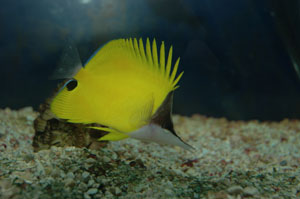|
|
Yellow longnose Butterflyfish – Forcipiger flavissimus
The yellow longnose butterflyfish, also called the forceps fish, comes from the Indo-Pacific ocean region from Hawaii southward into eastern and central Polynesia and then westward across the tropical Pacific Ocean, through the East Indies, and across the Indian Ocean to the coast of Africa and the Red Sea. This is a good first butterflyfish however, make sure to cycle the tank first.
Maximum Size: The yellow longnose butterflyfish should grow to a maximum size of 9.0 inches
Minimum Tank Size: The minimum tank size should be 75 gallons
Care Level: The yellow longnose butterflyfish is a moderate fish to keep. On a scale of 1 –10, (10 being easy) it would rate a “6”. The tank should already be cycled and considered mature.
Tank Conditions: Temperature 77-79°F; Specific gravity: 1.021 – 1.024; pH: 8.1 – 8.3; Nitrates should be no more than 10 ppm.
Color: The yellow longnose butterflyfish – as picture shows has a yellow body. The color of its head is divided horizontally. The upper half of the head, at the very top of the mouth through the top of the head is black. A black dot (false eye) is on the back end and below its anal fin.
Temperament: This is a good fish. It can ultimately become aggressive to other yellow longnose butterflyfish and fish closely colored. This is a butterflyfish that should do well in a peaceful community tank. You can possibly maintain a male and female together – they should be introduced to the tank together.
 Reef Compatible: May eat at and possibly destroy hard and soft corals, but we know of no people as of yet that have complained of this, as well as invertebrates and anemones. It will eat tube worms and urchins. Reef Compatible: May eat at and possibly destroy hard and soft corals, but we know of no people as of yet that have complained of this, as well as invertebrates and anemones. It will eat tube worms and urchins.
Diet: The yellow longnose butterflyfish is an basically a carnivore Typical meaty foods such as brine shrimp, clams, fish meat, butterflyfish preparations etc that can be purchased from your local store should be provided.
Habitat: Provide with plenty of hiding places and room to move around. Like most other butterflyfish, it is a fish that is sensitive to even the lowest levels of ammonia, as well as touchy to other changes in its environment relating to poor water quality issues. Good water circulation is important as well as high quality water maintenance. Filtration should include a protein skimmer and activated carbon filtration.
Compatibility: Butterflyfish in general can be kept with cardinalfish, catfish, filefish, firefish, gobies, grammas, rabbitfish to name a few and they should not be housed with groupers, sharks, lionfish or rays and can be a problem if housed with damselfish, basslets, surgeonfish, triggerfish and certain wrasses.
|
|
|
|



 Reef Compatible: May eat at and possibly destroy hard and soft corals, but we know of no people as of yet that have complained of this, as well as invertebrates and anemones. It will eat tube worms and urchins.
Reef Compatible: May eat at and possibly destroy hard and soft corals, but we know of no people as of yet that have complained of this, as well as invertebrates and anemones. It will eat tube worms and urchins.